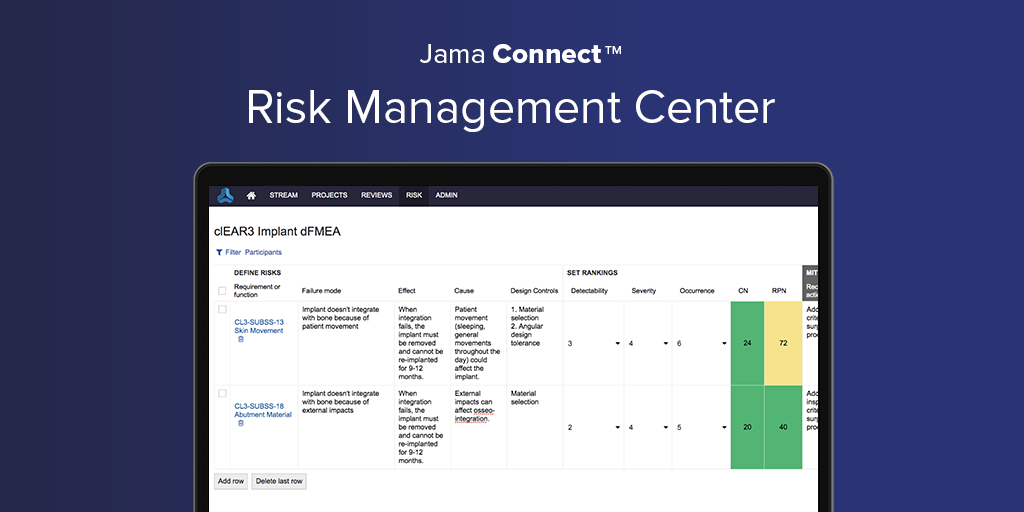Many products must go through a risk management process to ensure safety, but it’s the severity of the potential outcomes that vary.
For our customers creating products in heavily-regulated industries — such as automotive, medical devices, and aerospace — the consequences associated with not correctly mitigating risk puts lives in jeopardy. And there’s ample evidence that too many in these fields are still struggling to find a process that works.
Even while tougher safety regulations and standards are being enacted, product recalls are still soaring. In February and March alone, millions of vehicles were recalled due to quality issues. And, within the fourth quarter of 2018, recalls of medical devices spiked 449% to just over 161 million, which was the second highest quarter in at least 14 years.
These examples showcase why teams building complex products need a smarter way to identify the probabilities and severity of risks early so they can track and mitigate them throughout development. And while risk management is imperative, it can’t come at the expense of the speed of development; in fact, it should complement rather than hinder efficiency.
Earlier this year, we introduced Jama Connect™ Risk Management Center for medical device developers, and now we’re excited to announce that we’re opening it up to all our customers working within regulated industries with the introduction of FMEA templates.
The Jama Connect Risk Management Center was developed from best practices learned from our work with companies that deliver quality products in safety-critical industries. With the newly-updated Risk Management Center, development teams can participate in risk management techniques including Preliminary Hazard Analysis (PHA) and FMEA in accordance with ISO 14971 and IEC 60812.
As an overview, here are some common problems we’ve often seen around managing risk and how the Jama Connect Risk Management Center solves them.
Problem: Not sure how to implement a solid risk management process
Risk management is a daunting challenge, especially for startups vying to disrupt an entire industry. Whether it’s ISO 14971, IEC 60812, or beyond, many new companies aren’t sure where to start when creating a risk management plan to bring their products up to international standards and government regulations.
Solution: Pre-configured risk analysis templates and startup services
In Risk Management Center, users receive guided templates based on best practices like FMEA and ISO 14971, which helps remove the bulk of the guesswork.
For medical device developers, Jama also has a Professional Services division that can work directly with your team to provide the best possible start to your process in accordance with ISO 14971. Through training and consultation, they’ll help customize your templates in a way that matches your team’s risk management process so you can start managing and mitigating risks quickly while accelerating development.
Jama’s professional services dramatically speed time to value, so much so that one customer began developing medical devices in less than a week with our guidance.
Frost & Sullivan points to Jama Connect as a way to better manage risk for companies in regulated industries. Read the report.
Problem: Risk management process can be siloed
In many organizations, managing risk during development is painfully cumbersome, disconnected, and inefficient.
If you can imagine a company emailing gigantic Excel spreadsheets around to manage risks for large, complex products — whether its airplanes, automobiles, medical devices, or software that interacts with any of these elements — you can also envision the unintended errors that can manifest as a result.
Solution: Streamlined risk management
The Jama Connect Risk Management Center takes a strong, team-based approach, ensuring risk analysis is not done in silos and instead performed early, collaboratively, and continuously throughout development.
With your risks and requirements housed directly within Jama Connect, Risk Management Center helps you track both in a single place. And since the data in Jama Connect is updated in real time, you’ll always be working from the most recent version of any risk analysis. Invited individuals can simply log in to Jama Connect and participate throughout the development process.
Through this effort, risk management becomes a continuous and collaborative part of the development process saving you valuable time and rework cost.
Problem: Aligning teams around risk management
Throughout the frenzied pace of development, those charged with leading the risk management process at organizations can find it difficult to keep teams engaged and focused on reviewing risks. The issue often manifests itself in long, painful, cross-functional meetings, wherein risks are reviewed in detail.
By their very nature, cross-functional teams aren’t performing risk management full time. As a result, review meetings can become susceptible to the same problems all meetings are prone to: participants don’t prepare, precious meeting time is spent on what to focus on, and action items aren’t clearly identified or resolved. This type of disorganization can significantly extend the development cycle if risks are still discovered late in the design or commercialization phases – times when efficiency is most needed.
Solution: Centralized risk management activities
Lengthy meetings around risk management can be halved with the Jama Connect Risk Management Center. Throughout development, key stakeholders in the risk management process can be given select access to Risk Management Center.
These chosen team members can then easily and efficiently view and contribute to the risk analyses that matter most to their expertise and experience. Users also get the ability to easily bookmark, organize, and identify recently-viewed analyses so they can pick up right where they left off.
Organizations using dedicated requirements management platforms receive fewer warnings, recalls, fines, and production stoppages than those that don’t, according to Engineering.com. Get the full report.
Problem: Tracking accountability in risk management
If your team is still relying on spreadsheets when building complex products, that’s going to cascade into other problematic areas.
In the whirl of development cycles, it can be difficult to manage the multitudes of requirements and tasks, leaving teams with a sense of unease around whether or not they’ve properly tracked and mitigated all possible risks when it comes time to launch.
Solution: Visible risk tracking and mitigation
In Risk Management Center, you’ll have the ability to link risks to requirements and verifications to better manage development complexity and assess the impact of changes to ensure quality. This feature also allows you to easily track open risks and those that are still needing mitigations, effectively eliminating the chance something slips by your team.
When it comes time to prove compliance, risk analysis and plan elements can be easily exported to allow sign-off in another compatible document or management tool.
Learn more about Jama Connect Risk Management Center by downloading our datasheet or contacting your account manager.



